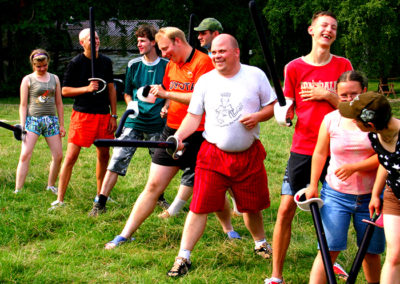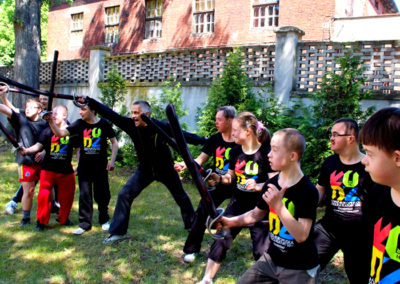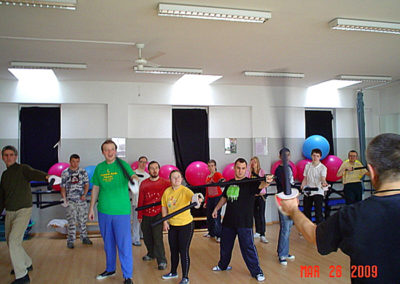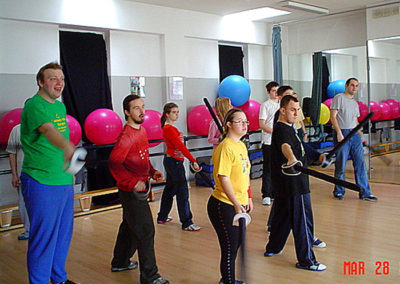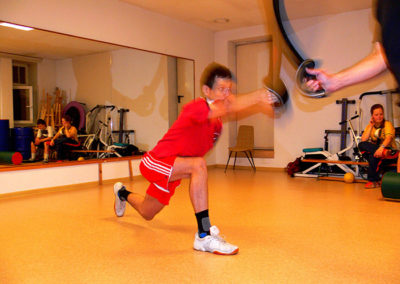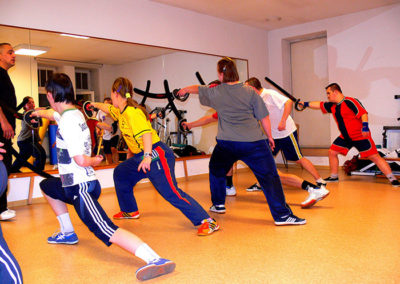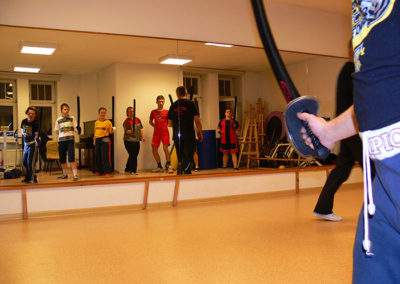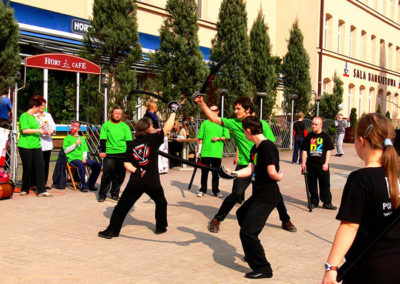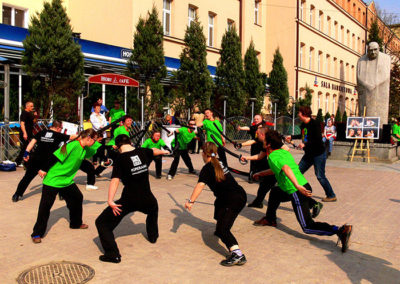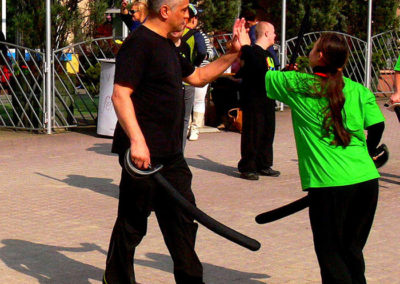Rehabilitation Achievements
First, my notes about the work with students from The Bidermann Palace.
The people I work with are mostly with Down syndrome. In minor cases with small mental disability, being a consequence of cerebral palsy during childhood. Classes take place in Łódź/Poland at Kilińskiego St. in former Bidermann Palace.
I’m using the term “Bidermann students”, first, because it’s hard for me to respond to them as to mentally disabled, as work with these wonderful, full of empathy and compassion people is much more “normal” than with those without any disability. It doesn’t mean of course that it’s easy and doesn’t have any negatives. Second – the Bidermanns, especially Maryla Bidermann, have been unforgettable in the memory of Łódź’s (and not only this city’s) citizens as people offering help to the ones who needed it.
Right now, the Bidermann Palace has been taken over a company called “Atlas”and its President is continuing the tradition of charity. Big respect!
I had my first classes with the Bidermann students on September 2008th. They all have demonstrated great interest and commitment. I thought that maybe they feel motivated to train fencing by film connotations. But it occurred it wasn’t that. Now, I think, that they are just very open minded and with wide curiosity towards new experiences.
Fencing is a martial sport. In short period of time students try to determine their domination. In that time implementing discipline and drawing their attention to commitment, ethics and etiquette is essential. This isn’t hard as they have been gifted with these terms. But please don’t get me wrong. Bidermann students aren’t saints. I needed to introduce them the concept of discipline, ethics (emphatic) and etiquette – keeping forms, listening to the instructor, respecting the rules, understanding their training co-partner and principles of chic competition.
Every student needs “individual study program”. That’s why the instructor should have a helping hand. It would be best if parents get involved, but I know it’s not so easy to achieve. That’s why participation of volunteers or hired helpers is essential.
In the end, groups can be small enough (3 persons) so that one instructor could manage. But it’s the least favourable approach, because work in larger teams gives you a greater power and appropriate affirmation.
This was a part of Dariusz Wadowski’s notes about work with Bidermann’s students

Description of therapeutical and rehabilitation achievements of participants of Go-Now classes.
The students are from Stowarzyszenie Rodziców i Opiekunów Chorych z Zespołem Downa in Łódź. Here are just parts of description by Magda Hofman – Alan’s mum

ALAN, 11 years old, Down syndrome
Throughout his first class he sat on the bench and just observed how others exercise. He didn’t move from the bench for the whole hour. I was devastated. I’ve waited for this class, because my younger son just started training Aikido and Alan also took this class, but then resigned. I wanted Alan to feel same important as his brother. And I wanted him to move, exercise his muscles, train coordination and spatial orientation. I didn’t resign and I took him for another meeting with the trainer and his broadswords.
In the mine time I had a talk with my son about sport and its importance and the need of training any sport discipline and that the broadswords are ideal for boys, so masculine and hard, not everyone can manage, only the best ones (it was kind of a trick).
My son’s adventure with fencing, with systematic work and exercises started from the second meeting. I’m very much surprised how he’s coping. He’s not only not staying behind, but he’s just FANTASTIC!!!
He’s close to properly reacting to commands, because he’s right and left handed at the same time, he’s doing fantastic work on both sides. It’s a revelation for coordination. Conditionally he’s keeping up to 3 classes in a row, as he doesn’t want to go home after his training, so he’s staying on later classes too.
I’ve noticed he’s trying to follow exactly the commands, he cares for success and a praise from the trainer in front of the group. He’s disciplined, listens carefully to the commands.
He’s got a problem with the footwork. When he’s supposed to stand in a stance, he’s standing on straight and stiff legs. His defence from thrusts is fantastic, he’s fast, nicely parries the attacks. The jump ups are done poorly, because of stiff legs.
He’s memorized five fence blocks very quickly and also five places to attack (head, neck, hand, torso and legs).
The battle cry for me is an ideal way for the emotions to burst out, emotions that cumulate in normal living conditions, that are tempered and stopped. I think that this is a very important part of the training and it is necessary. These are my observations after a month of training.
Three months of classes have passed. Alan has definitely improved his footwork and coordination. But he’s got a problem with starting the class. What do I mean by that? When the class starts, Alan is greeting with everyone, taking part in a warm up, and then moving aside, sitting on the window still and observing others. We have to encourage him long and use different tricks and eventually he joins in the training. When we overcome his first resistance, his sparrings are fantastic. We exercise in pairs the parries and defences with moving in fencing walk at the same time. That is, competitor A is moving one step forward, competitor B is moving one step backward. Then we’re doing the same with two steps in a row. Two steps forward, and the opponent does two steps backward. For children with coordination and spatial orientation disorder, it’s a very hard exercise. And there’s more to it, doing this exercise, at the same time they have to practice attacks and parries and jump aside from the opponent to avoid being hit.
Alan is performing this task very well. He has improved his standing position. His legs aren’t so stiff anymore and he’s started working with them. He’s moving his weight from one leg to the other. He’s not doing this perfectly yet, but I’m very happy that this have appeared and that it has an impact on how he moves everyday.
I’ve noticed that the classes have not only got a positive effect on physical progress, but also on emotional development. After a whole week’s work at school, after school’s rehabilitation and educational therapies, at the end of the week, Alan is frustrated and he’s a bundle of nerves. Fencing trainings relieve negative energy, tension, they calm him down, right teaching and bringing up the class boosts my son’s self-esteem, he’s got a reason to be satisfied and opportunity to show his achievements, and then display them in front of his family at home, where he’s praised again. It is very important for disabled people, as they are often exposed to failure in other areas of life.

MAŁGORZATA (MARGARET) ZBRZEZNY – cerebral palsy by Magda Hofman – Alan’s mum
Margaret has started her rehabilitation when she was 5. She’s got cerebral palsy.
The girl joined our class in half of March. She’s a high, well built girl. She’s got problems with standing, walking and sitting down. Vey big coordination disorder. She didn’t want to exercise on the first training and she spent it on the mattress observing others work out. She joined the class at the very end of it and we had an impression she already knows basic fencing defence techniques – the star. She performed them holding the broadsword incorrectly. Too close to the face, legs and the whole body. But her eyes were shining bright and she was smiling with the whole of herself. She couldn’t jump, none footwork. Frail and unstable position.
Every meeting had brought surprising effects. The defence better each time, broadsword in the right distance from the protected parts of the body, and the most wonderful gift for the trainer – the jump!!! Margaret lifted her body from the floor, in a jump, for the very first time in her life. Contact with her is phenomenal. From March to May, you can say, the girl bloomed in fencing. In sparrings from one training to another she is better in moving around, defending from the thrusts and carrying out the hits. There’s still a lot of work ahead of her. Strengthening legs, dorsum, hands needs to be done and work on her stance. She needs to stiffen and strengthen her initial posture. Now it is frail and unstable. When you look at her she seems to look like she’s swimming, that’s why it’s harder for her to carry out hits and defend from them.
Margaret is a discovery! When you think of her, you want to work harder on your own imperfections, because you start to believe in yourself. A FANTASTIC girl!
3rd of December 2010 by Magda Hofman – Alan’s mum
Margaret, I haven’t written about her for a year now. It’s because I’m not in her group. Today I had this possibility and joy of participating in her class. What she has presented stuck me with surprise, entranced me. First thing – her SMILE, she doesn’t normally wear it on her face (Magda meets Margaret at other classes). She exercised with great ease, eagerly, she was full of energy. It all astonished me. She was not only performing the exercises, she also took part in simulated duel!!! She was parrying the attacks and hitting, achieving the hits and what’s more – she also followed the opponent. That was a SHOCK! When making a thrust she was doing a loud shout – war cry. Those who don’t know Margaret don’t realize how much she’s closed inside herself. In fact there’s not much contact with her at all. At least it seemed that way. She moves heavily, with “swimming” steps, like a jelly. Basically she doesn’t talk; at least I haven’t heard her talking. But when she’s fencing, she’s like with invisible wings, that lift this girl up and give her lightness of a feather. She’s screaming, fighting and moving ahead like thunder with a Go-Now sword in a hand. And, my dear recipients, she’s also playing Go-Ball (Go-Now ball competition).
I should mention here that she’s never going to move lightly like a ballet dancer. Nor jump like an Olympian. But Margaret has always been on the loser’s side, labelled that way by everyone; her achievements on the fencing class are amazing.
It’s not hard to teach anything a healthy, smart and clever person. The difficulty is to get through to a person with huge problems. To a person, who’s disordered, closed, disabled, blocked, with zero self-esteem, understood by no one else but parents. So please, can anyone tell me that Margaret hasn’t already won a medal?!! And bows for the trainer, I know, because I’ve seen it. I praise, because I don’t know many people who understand as well as he does.

BARTEK (BART) – 11 years old, Down syndrome by Magda Hofman
The boy didn’t want to cooperate for the first two or three trainings; at least it looked that way. He often went to the bathroom, went to sit at the bench, and rested. He couldn’t keep the right fencing posture, he mistook the sides. Also exercises with broadswords, defends and attacks, didn’t come out the way he wanted, so it disturbed him more and made him angrier. But patience, help from his mum, motivation from the whole group and the trainer made him want. Two last trainings, we can say, were The Bart’s trainings.
I’ve never seen the boy as much concentrated, motivated and determined to perform the exercises. Although he has problems with the right posture, he let his body to be set and lead and didn’t give up. During the last exercises you could feel his determination. He eagerly took part in the sparrings, he didn’t defy himself if the exercise needed to be repeated. His team work was alright, what didn’t take place before. He doesn’t have the sense of his power and still hits too roughly, but he’s trying. He doesn’t remember the defence techniques and looses himself if someone attacks him quickly and he doesn’t remember how to defend himself from certain hit. I think it’s just a matter of time. But he has opened himself and enjoys fencing.
Observations after one month of trainings.
9th June 2010
Last month of trainings under a watchful eye of the trainer is coming. End of classes where students practice from the beginning till the end of the training. Bart – headstrong, very fidgety, unsubordinated; in front of our eyes changed into a concentrated, disciplined, willing to do his best in exercises competitor. Yes, competitor! His progress is spectacular, surprising and heart whelming.
He’s standing in the starting posture. He’s doing warming up, power, and eye and movement coordination improving exercises. The boy must be treated with patience, the commands must be given several times and shown to him alone so that he would understand what to do. But his commitment is surprising. He’s got slow reflex and concentration problems. While he’s attacking he’s looking around the classroom at the same time and looking for some help instead of using his own abilities, though his skills get better and better each time. But his commitment and full reliance on the trainer are just great. At the beginning of his adventure with the broadswords he was so fidgety, dispirited, disheartened. Without faith in his own abilities. This boy is really trying hard and doing enormous work with himself. Thanks to this broadsword practice with its discipline that he has taken freely, willingly, his relations with peers have also changed. He’s not an egoist, paying more attention to others now and he’s more communicative. I believe it’s just the beginning of his great change.
The technique can be improved, muscles strengthened, but if it wasn’t for GO-NOW fencing enthusiasm, this would have never taken place.
These are my impressions after these few months of work with Bart (helping the trainer).
17th of October 2010
I have this strange feeling that Bart during the training moves like a jelly. All parts of his body seem to live their own life. He’s not able to concentrate his sight long enough on his opponent, he’s not looking in the direction he’s making the attack. The boy is trying hard but his moves are disordinated.
The hardest thing is to keep the right posture. He remembers the defence techniques, but he’s making them with a delay. He’s doing the hits in all directions.
The only thing which is strong, good and dominating is his strong endeavour and commitment. What I mean by endeavour is, knowing Bart well I know how much he gets distracted, sometimes it may seem he’s naughty, but it’s not that, he just wants to be noticed. Very active, quickly getting bored kid. That’s why saying endeavour I mean how much sacrifice it takes for him to concentrate and be disciplined during the training and how much he wants to be a brilliant fencer. Though he’s got lack in technique, posture and poor motion coordination, his improvement is really big. Still much work to be done on his posture, steps when he’s moving in fencing steps and then changes to a fencing position and on concentration. It can’t be this way that he’s not looking at his opponent when he’s making an attack and he’s moving his broadsword to all directions.
But his strong side is good condition and stamina. People with Down syndrome usually get tired very quickly. They can take strenuous physical exercise, but only for short time and then they have to rest. Of course it can be exercised, but please remember that it’s not that they don’t want to work out, but it’s this extra chromosome they have, which has messed it all up.

JACEK (JACK) LEWANDOWSKI, 29 years old, Down syndrome
5th December 2010
Jack started his fencing trainings a year ago. Poor coordination, stiff, blocked knees, he practically didn’t move during a sparring, slow reaction to commands, easy deconcentrated. He was afraid to parry hits. His hits didn’t reach the opponents, as he stopped his broadsword in a distance to his partner with whom he practiced. He gets quickly irritated, ready to quit just after one failure.
Today his progress is unbelievable. If I haven’t seen it by myself – Jack at the beginning of his adventure with Go-Now fencing, I wouldn’t believe that such progress is possible.
Jack is exercising nearly correctly. He is concentrated and obedient. He gracefully takes the On Guard Position. He defends quicker and more resolutely. He started working with his feet, there’s some movement when sparring. His hits reach and aim the opponent. He doesn’t stop in the middle while attacking.
I think there’s still some footwork to be done. Though he made a big progress, his stance still isn’t correct. His balance is limited. Jack has problems with putting his body weight from one side to the other. He is too much concentrated on one action to cope with another, e.g. when he’s concentrated to attack the legs, he doesn’t protect his head or shoulders. He doesn’t parry the attacks just runs like an aurochs and performs hits in concrete direction. He forgets that he should defend first and try to hit afterwards. He’s still too slow. His reflex is poor.
To sum up my reflexion after this training. It was very pleasant to fight with Jack. He’s not the same competitor. He used to be scared, undecided, moving like a jelly.
